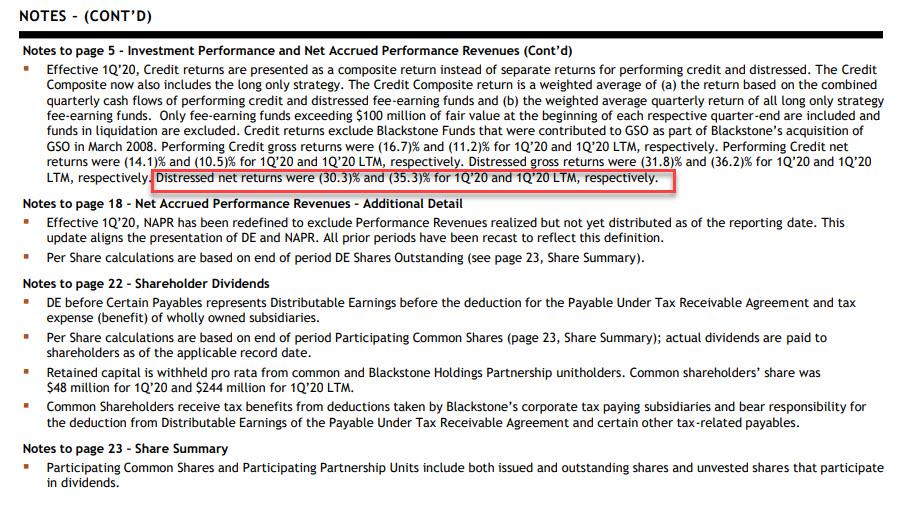Blackstone’s Distressed-Debt Fund Suffers Record Loss On Energy Investments
A distressed investor should, as the name implies, be able and successful to navigate markets and deliver outsided returns on distressed assets especially during distressed times. Alas, in the case of Blackstone’s distressed credit arm, GSO Capital Markets, the opposite was true, and in the first quarter of 2020, the fund delivered its worst quarterly performance ever.
According to a presentation posted on Thursday, or rather a footnote buried in the last pages of the presentation…
… GSO – once a wrecking ball in the distressed debt space and the company that singlehandedly broke the CDS market so badly, even Goldman accused it of destroying the Credit Default Swap market back in 2018 – returned a net -30.3% in Q1. The losses were driven mostly by its investments in the energy sector, which crippled returns and have emerged as the sector that is below “distressed” in the cap structure.
The loss compares to a 3.1% gain in Q1 a year ago, and a negative 1.1% in the last quarter of 2019, when energy was also a drag as Bloomberg notes. The company will post even worse returns for Q2, when a supply glut and crashing demand sent oil futures prices into negative territory during April, and unleashed a liquidation wave among energy bonds and stocks, with countless shale companies expected to go bankrupt.
Meanwhile, for the last 12-months, net returns were also down 35.3%, according to Blackstone’s presentation. By contrast, GSO posted a negative 14.1% net return on its performing credits for the quarter.
“We’re already seeing opportunities appearing” from dislocation in the markets, but “distress takes time to play out,” Chief Operating Officer Jonathan Gray said on the call. The firm is “looking for businesses that are cyclically, not secularly, under pressure,” Gray said. “Strong companies and properties recover and flourish with time.”
While cool-sounding, the name “distressed” in the title of a fund appears to only reflect the fund’s own prospects these days. While in good years, there are virtually no distressed assets, in bad years, the distressed assets tend to go from part straight to bankruptcy, without passing go, which makes a mockery of any fund that tries to time a recovery.
As Bloomberg notes, “investors in distressed debt struggled to post gains last year because low interest rates and frothy credit markets helped troubled issuers find new backers to bail them out. Now the coronavirus pandemic has created new targets for credit investors to buy at steep discounts, with the total approaching $1 trillion at one point during March, according to data compiled by Bloomebrg.”
Alas, it appears that GSO bought too early and is now waiting for the waves of bailouts to at least push asset prices to its cost basis.
“It’s a better investment environment than it was before both the leveraged loan and high-yield market sold off,” Gray said on the call. Those markets have recovered some ground, “but there are still plenty of names that are trading at big discounts, so for our distressed arm that creates opportunities.”
Which is just what anyone else who is down 30% would say: focus on the future, ignore the past.
In any case, in hoping of dollar-cost averaging lower, management said that the firm deployed roughly $3 billion during the first quarter, when the amount of assets specific to distressed-debt investing was around $7.8 billion, or about 1% of Blackstone’s total $538 billion pool.
According to Bloomberg, the entire credit unit managed $128.7 billion as of quarter end, a step down from $132.3 billion in the same period last year. Credit remains the third-largest business unit at Blackstone. Blackstone’s supply of unused capital available to invest in credits of all types and insurance stood at $27.9 billion, down from $28.7 billion in the prior quarter.
GSO is watched closely by investors because it’s one of the largest and most active distressed-debt investors. Returns in the field can vary widely each quarter, with results depending in part on when troubled issuers decide to take corrective actions and when deals are completed as well as court rulings.
GSO’s composite gross return for distressed assets before fees and deductions was down 31.8% for the quarter, better than the 41% drop in the benchmark ICE BofA distressed-debt index. The results trailed both GSO’s 3.7% gain in the first quarter of 2019 and negative 0.8% in the fourth quarter of last year.
And while Blackstone had a dismal quarter, Q2 may be catastrophic. The reason: the company’s aggressive expansion in the junk-rated energy space, which is now set for a record deluge of bankruptcies. In June of 2019, GSO raised $4.5 billion for one of the largest energy-focused credit funds ever. Any funds from that pool that were invested in the energy sector is likely worthless now.
The full Blackstone presentation can be found here.
Tyler Durden
Thu, 04/23/2020 – 14:49

